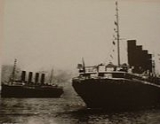
Four funnel liner
Encyclopedia
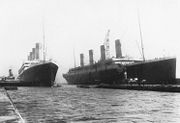
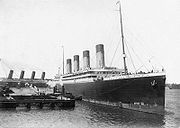
Ocean liner
An ocean liner is a ship designed to transport people from one seaport to another along regular long-distance maritime routes according to a schedule. Liners may also carry cargo or mail, and may sometimes be used for other purposes .Cargo vessels running to a schedule are sometimes referred to as...
with four funnel
Chimney
A chimney is a structure for venting hot flue gases or smoke from a boiler, stove, furnace or fireplace to the outside atmosphere. Chimneys are typically vertical, or as near as possible to vertical, to ensure that the gases flow smoothly, drawing air into the combustion in what is known as the...
s. The SS Great Eastern
SS Great Eastern
SS Great Eastern was an iron sailing steam ship designed by Isambard Kingdom Brunel, and built by J. Scott Russell & Co. at Millwall on the River Thames, London. She was by far the largest ship ever built at the time of her 1858 launch, and had the capacity to carry 4,000 passengers around the...
, launched on January 31st 1858 (a full 40 years ahead of her contemporaries), became the only ocean liner to ever sport five funnels. As one funnel was later removed, the Great Eastern, by default, became the first ocean liner to have four funnels. The SS Kaiser Wilhelm der Grosse, launched on May 4th 1897, was the next ocean liner to have four funnels and was one of the first of the golden era of ocean liners that become prominent in the early to mid 20th century. The most famous four funnel liners are the RMS Titanic, which sank after striking an iceberg on her maiden voyage on April 15th 1912, and the RMS Lusitania
RMS Lusitania
RMS Lusitania was a British ocean liner designed by Leonard Peskett and built by John Brown and Company of Clydebank, Scotland. The ship entered passenger service with the Cunard Line on 26 August 1907 and continued on the line's heavily-traveled passenger service between Liverpool, England and New...
, which was torpedoed on May 7th 1915 during World War One.
In all, fifteen four funnel liners were built (5 were built and owned by Germany, 9 by the UK, and 1 by France): the Great Eastern in 1858 and the remaining fourteen between 1897 and 1922. Four of these were sunk during the World Wars, and apart from the Titanic, the remainder were scrapped. RMS Mauretania
RMS Mauretania (1906)
RMS Mauretania was an ocean liner designed by Leonard Peskett and built by Swan, Hunter & Wigham Richardson at Wallsend, Tyne and Wear for the British Cunard Line, and launched on 20 September 1906. At the time, she was the largest and fastest ship in the world. Mauretania became a favourite among...
was the fastest of all four funnelled liners. The last four funnelled liner ever built was the SS Windsor Castle
SS Windsor Castle (1922)
The first RMS Windsor Castle, along with her sister, , was an ocean liner laid down by the Union-Castle Line for service from the United Kingdom to South Africa. Originally laid down in 1916, their construction was held up by the First World War. They were not completed until 1922. They were the...
but her two funnels were removed making RMS Aquitania
RMS Aquitania
RMS Aquitania was a Cunard Line ocean liner designed by Leonard Peskett and built by John Brown & Company in Clydebank, Scotland. She was launched on 21 April 1913 and sailed on her maiden voyage to New York on 30 May 1914...
the last four funnel liner in service; the Aquitania was the largest of all the four funnel liners and the only one to survive through both World Wars.
List of four funnel liners
| Picture | Liner[a] | Owner | Launched | Fate |
|---|---|---|---|---|
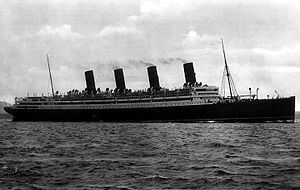 |
RMS Aquitania RMS Aquitania RMS Aquitania was a Cunard Line ocean liner designed by Leonard Peskett and built by John Brown & Company in Clydebank, Scotland. She was launched on 21 April 1913 and sailed on her maiden voyage to New York on 30 May 1914... |
Cunard Line Cunard Line Cunard Line is a British-American owned shipping company based at Carnival House in Southampton, England and operated by Carnival UK. It has been a leading operator of passenger ships on the North Atlantic for over a century... |
21 April 1913 | scrapped 1950 |
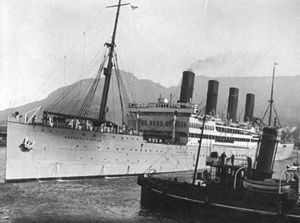 |
SS Arundel Castle SS Arundel Castle The RMS Arundel Castle was a British ocean liner which entered service in 1921 for the Union-Castle Line. Her sister ship was the SS Windsor Castle; they were the only four-funneled liners not built for transatlantic service... [b] |
Union-Castle Line Union-Castle Line The Union-Castle Line was a prominent British shipping line that operated a fleet of passenger liners and cargo ships between Europe and Africa from 1900 to 1977. It was formed from the merger of the Union Line and Castle Shipping Line... |
11 September 1919 | scrapped 1959 |
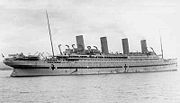 |
HMHS Britannic HMHS Britannic HMHS Britannic was the third and largest of the White Star Line. She was the sister ship of and , and was intended to enter service as a transatlantic passenger liner. She was launched just before the start of the First World War and was laid up at her builders in Belfast for many months before... [c][d] |
White Star Line White Star Line The Oceanic Steam Navigation Company or White Star Line of Boston Packets, more commonly known as the White Star Line, was a prominent British shipping company, today most famous for its ill-fated vessel, the RMS Titanic, and the World War I loss of Titanics sister ship Britannic... |
26 February 1914 | sunk 21 November 1916 |
.jpg) |
SS Deutschland SS Deutschland (1900) SS Deutschland was a passenger liner owned by the Hamburg America Line of Germany. She sailed for over 25 years under three different names. The second ship to have been built as a four funnel liner, she was built by Hamburg America as a response to the SS Kaiser Wilhelm der Grosse. She was the... |
Hamburg-Amerika Line | 1900 | scrapped 1925 |
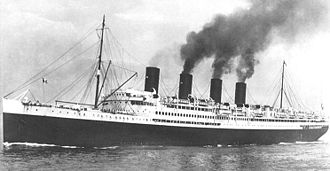 |
SS France SS France (1912) The SS France was a French ocean liner which sailed for the Compagnie Générale Transatlantique, colloquially known as CGT or the "French Line". She was the only French liner to have the famous Four stackers, she was later dubbed the Versailles of the Atlantic, a reference to her décor which... |
Compagnie Générale Transatlantique Compagnie Générale Transatlantique The Compagnie Générale Transatlantique , typically known overseas as the French Line, was a shipping company established during 1861 as an attempt to revive the French merchant marine, the poor state of which was indicated during the Crimean War of 1856... |
1910 | scrapped 1935 |
 |
SS Great Eastern SS Great Eastern SS Great Eastern was an iron sailing steam ship designed by Isambard Kingdom Brunel, and built by J. Scott Russell & Co. at Millwall on the River Thames, London. She was by far the largest ship ever built at the time of her 1858 launch, and had the capacity to carry 4,000 passengers around the... [e] |
Great Ship Company | 31 January 1858 | scrapped 1889–90 |
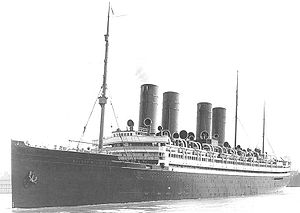 |
SS Kaiser Wilhelm II SS Kaiser Wilhelm II The second SS Kaiser Wilhelm II, was a 19,361 gross ton passenger steamer built at Stettin, Germany, completed in the spring of 1903. A famous photograph taken by Alfred Stieglitz called The Steerage as well as descriptions of the conditions of travel in the lowest class have conflicted with her... [f] |
North German Lloyd Line | 12 August 1902 | scrapped 1940 |
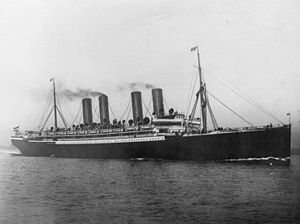 |
SS Kaiser Wilhelm der Grosse[f] | North German Lloyd Line | 4 May 1897 | sunk 6 August 1914; wreck dismantled on site in 1952 |
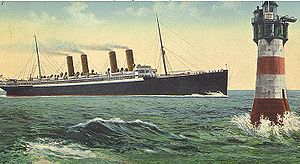 |
SS Kronprinz Wilhelm SS Kronprinz Wilhelm SS Kronprinz Wilhelm was a German passenger liner built for the Norddeutscher Lloyd, a former shipping company now part of Hapag-Lloyd, by the AG Vulcan shipyard in Stettin, in 1901... [f] |
North German Lloyd Line | 30 March 1901 | scrapped 1923 |
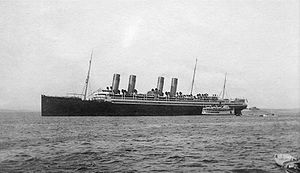 |
SS Kronprinzessin Cecilie SS Kronprinzessin Cecilie SS Kronprinzessin Cecilie was an ocean liner built in Stettin, Germany in 1906 for North German Lloyd that had the largest steam reciprocating machinery ever fitted to a ship. The last of four ships part of the kaiser class, she was also the last German ship to have been built with four funnels.... [f] |
North German Lloyd Line | 1 December 1906 | scrapped 1940 |
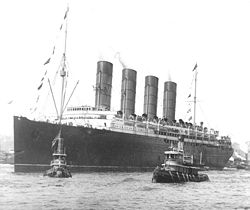 |
RMS Lusitania RMS Lusitania RMS Lusitania was a British ocean liner designed by Leonard Peskett and built by John Brown and Company of Clydebank, Scotland. The ship entered passenger service with the Cunard Line on 26 August 1907 and continued on the line's heavily-traveled passenger service between Liverpool, England and New... |
Cunard Line | 7 June 1906 | sank 7 May 1915 |
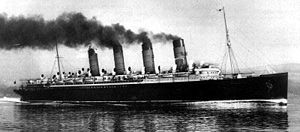 |
RMS Mauretania RMS Mauretania (1906) RMS Mauretania was an ocean liner designed by Leonard Peskett and built by Swan, Hunter & Wigham Richardson at Wallsend, Tyne and Wear for the British Cunard Line, and launched on 20 September 1906. At the time, she was the largest and fastest ship in the world. Mauretania became a favourite among... |
Cunard Line | 20 September 1906 | scrapped 1935 |
| RMS Olympic RMS Olympic RMS Olympic was the lead ship of the Olympic-class ocean liners built for the White Star Line, which also included Titanic and Britannic... [d] |
White Star Line | 20 October 1910 | scrapped 1935–37 | |
| RMS Titanic[d] | White Star Line | 31 May 1911 | sank 15 April 1912 | |
| SS Windsor Castle SS Windsor Castle (1922) The first RMS Windsor Castle, along with her sister, , was an ocean liner laid down by the Union-Castle Line for service from the United Kingdom to South Africa. Originally laid down in 1916, their construction was held up by the First World War. They were not completed until 1922. They were the... [b] |
Union-Castle Line | 9 March 1921 | sunk 23 March 1943 |
Notes:
[a] SS denotes Steamship
Steamboat
A steamboat or steamship, sometimes called a steamer, is a ship in which the primary method of propulsion is steam power, typically driving propellers or paddlewheels...
, RMS denotes Royal Mail Ship
Royal Mail Ship
Royal Mail Ship , usually seen in its abbreviated form RMS, a designation which dates back to 1840, is the ship prefix used for seagoing vessels that carry mail under contract by Royal Mail...
, HMHS denotes His/Her Majesty's Hospital Ship
Hospital ship
A hospital ship is a ship designated for primary function as a floating medical treatment facility or hospital; most are operated by the military forces of various countries, as they are intended to be used in or near war zones....
[b] Originally constructed with four funnels, two were removed during later modernization.
[c] The Britannic was originally called Gigantic but she was renamed after the Titanic
[d] The last funnels on the White Star trio Olympic-class were dummies.
[e] Originally constructed with five funnels, her No. 4 funnel was later removed after she was sold for cable laying
[f] The group Kaiser-class four funnel liners owned by North German Lloyd Lines were called the Four Flyers.
City of Dublin Steam Packet Company
These four sister ships were unusual in having four funnels owned by City of Dublin Steam Packet CompanyCity of Dublin Steam Packet Company
The City of Dubin Steam Packet Company was a shipping line established in 1823. It served cross-channel routes between Britain and Ireland for over a century. For 70 of those years it transported the mail...
, the Ulster, Munster, Leinster, and Connaught were all built to have high speed and to be far ahead of anything afloat at the time. These four ships all had the same design, 1700 gross tons, 337 ft long, and had two-cylinder oscillating engines of about 750 nhp, and had four powerful paddle steamers. The last of the quartet, Connaught, was the first steamer to exceed 18 knots in the world.
- RMS Connaught (1) (1860)
- RMS Leinster (1) (1860)
- RMS Munster (1) (1860)
- RMS Ulster (1) (1860)
Isle of Man Steam Packet Company
- Ben-my-Chree (2) (1875) - a four funnel paddle liner owned by Isle of Man Steam Packet Company.
Purpose of four funnels

The trend of competing shipping lines building four funnel liners encompassed a very short time span ranging from the SS Kaiser Wilhelm der Grosse in 1897 to the SS Windsor Castle
SS Windsor Castle (1922)
The first RMS Windsor Castle, along with her sister, , was an ocean liner laid down by the Union-Castle Line for service from the United Kingdom to South Africa. Originally laid down in 1916, their construction was held up by the First World War. They were not completed until 1922. They were the...
in 1922. As for the number of funnels in some cases the reason for sporting four was a matter of necessity in other cases it was more symbolic. The Cunard Line
Cunard Line
Cunard Line is a British-American owned shipping company based at Carnival House in Southampton, England and operated by Carnival UK. It has been a leading operator of passenger ships on the North Atlantic for over a century...
record holders Lusitania
RMS Lusitania
RMS Lusitania was a British ocean liner designed by Leonard Peskett and built by John Brown and Company of Clydebank, Scotland. The ship entered passenger service with the Cunard Line on 26 August 1907 and continued on the line's heavily-traveled passenger service between Liverpool, England and New...
and Mauretania
RMS Mauretania (1906)
RMS Mauretania was an ocean liner designed by Leonard Peskett and built by Swan, Hunter & Wigham Richardson at Wallsend, Tyne and Wear for the British Cunard Line, and launched on 20 September 1906. At the time, she was the largest and fastest ship in the world. Mauretania became a favourite among...
were both laid out with four boiler rooms with one funnel to each room, other slower ships such as the Olympic
RMS Olympic
RMS Olympic was the lead ship of the Olympic-class ocean liners built for the White Star Line, which also included Titanic and Britannic...
, Titanic and Britannic
HMHS Britannic
HMHS Britannic was the third and largest of the White Star Line. She was the sister ship of and , and was intended to enter service as a transatlantic passenger liner. She was launched just before the start of the First World War and was laid up at her builders in Belfast for many months before...
only had three operational funnels. However sporting four funnels represented power, safety and prestiege, in keeping with the style and fashion of the early 20th century the White Star Line
White Star Line
The Oceanic Steam Navigation Company or White Star Line of Boston Packets, more commonly known as the White Star Line, was a prominent British shipping company, today most famous for its ill-fated vessel, the RMS Titanic, and the World War I loss of Titanics sister ship Britannic...
opted to fit the Olympic Trio with 'dummy' fourth funnels in order to portray them to the public as complete rivals to the Cunard duo. The ideology of four funnels representing size and power rapidly diminished soon after World War One, later larger flagships including the SS Imperator
SS Imperator
SS Imperator was an ocean liner built for the Hamburg Amerikanische Packetfahrt Actien Gesellschaft launched in 1912. She was the first of a trio of successively larger Hamburg America ships that included and built by the line for transatlantic passenger service...
, SS Normandie
SS Normandie
SS Normandie was an ocean liner built in Saint-Nazaire, France for the French Line Compagnie Générale Transatlantique. She entered service in 1935 as the largest and fastest passenger ship afloat; she is still the most powerful steam turbo-electric-propelled passenger ship ever built.Her novel...
and the RMS Queen Mary
RMS Queen Mary
RMS Queen Mary is a retired ocean liner that sailed primarily in the North Atlantic Ocean from 1936 to 1967 for the Cunard Line...
all sported three funnels to conserve deck space, later still as shipbuilding became more efficient the RMS Queen Elizabeth
RMS Queen Elizabeth
RMS Queen Elizabeth was an ocean liner operated by the Cunard Line. Plying with her running mate Queen Mary as a luxury liner between Southampton, UK and New York City, USA via Cherbourg, France, she was also contracted for over twenty years to carry the Royal Mail as the second half of the two...
, RMS Mauretania (II)
RMS Mauretania (1938)
RMS Mauretania was launched on 28 July 1938 at the Cammell Laird yard in Birkenhead, England and was completed in May 1939. A successor to RMS Mauretania , the second Mauretania was the first ship built for the newly formed Cunard White Star company following the merger in April 1934 of the Cunard...
and the SS America
SS America (1940)
SS America was an ocean liner built in 1940 for the United States Lines and designed by the noted naval architect William Francis Gibbs. She carried many names in the 54 years between her construction and her 1994 wrecking, as she served as the SS America , the USS West Point, the SS Australis, the...
reduced this further down to two funnels, today's modern cruise ships are all built with only a single funnel and many military vessels no longer sport them at all.
Unfinished four-funnel liners

Cunard Line
Cunard Line is a British-American owned shipping company based at Carnival House in Southampton, England and operated by Carnival UK. It has been a leading operator of passenger ships on the North Atlantic for over a century...
and White Star Line
White Star Line
The Oceanic Steam Navigation Company or White Star Line of Boston Packets, more commonly known as the White Star Line, was a prominent British shipping company, today most famous for its ill-fated vessel, the RMS Titanic, and the World War I loss of Titanics sister ship Britannic...
and France's Compagnie Générale Transatlantique
Compagnie Générale Transatlantique
The Compagnie Générale Transatlantique , typically known overseas as the French Line, was a shipping company established during 1861 as an attempt to revive the French merchant marine, the poor state of which was indicated during the Crimean War of 1856...
. Each of these three were operating aging vessels and required new larger and more modern 1000 ft long superliners to remain competitive. CGT began construction of the SS Normandie
SS Normandie
SS Normandie was an ocean liner built in Saint-Nazaire, France for the French Line Compagnie Générale Transatlantique. She entered service in 1935 as the largest and fastest passenger ship afloat; she is still the most powerful steam turbo-electric-propelled passenger ship ever built.Her novel...
while Cunard placed an order for the RMS Queen Mary
RMS Queen Mary
RMS Queen Mary is a retired ocean liner that sailed primarily in the North Atlantic Ocean from 1936 to 1967 for the Cunard Line...
. The weakest company of the three White Star placed an order to their shipbuilders Harland and Wolff
Harland and Wolff
Harland and Wolff Heavy Industries is a Northern Irish heavy industrial company, specialising in shipbuilding and offshore construction, located in Belfast, Northern Ireland....
for the Oceanic III
Oceanic (unfinished ship)
Oceanic was the planned name of an unfinished ocean liner that was partially built by Harland and Wolff for the White Star Line. The ship was to have been the first -long ocean liner....
, a successor to the lines inaugural liner, the RMS Oceanic
RMS Oceanic (1870)
RMS Oceanic was the White Star Line's first liner and an important turning point in passenger liner design.-Design and construction:Oceanic was built by Harland and Wolff in Belfast, and was launched on 27 August 1870, arriving in Liverpool for her maiden voyage on 26 February 1871...
of 1870. The exact intended design of the Oceanic III is unknown, although company concept renderings show it to be a three-funneled 1000-foot liner. However, plans from Harland and Wolff's archives show a design drawn in 1927 for a four funneled liner almost identical to the Olympic-class design except sporting a more modern Cruiser stern.
With the onset of the great depression the shipping lines were crippled. The completion of Cunards Queen Mary was delayed for four years and in order to raise the funds to complete her the British government gave Cunard a loan on the condition that Cunard merge with White Star into a single British shipping line. Upon the merger into the Cunard White Star Line the Oceanic (III) with only her keel laid was abandoned. Had this 1927 design been realized she would have been the White Star Lines crowning achievement, a fourth Olympic-class liner over 1000 ft long and the last ocean liner to date to sport four funnels.

